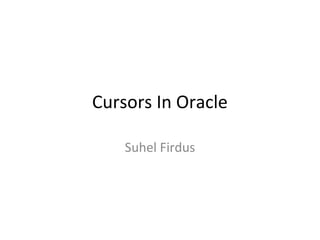Basic cursors in oracle
•Als PPT, PDF herunterladen•
0 gefällt mir•1,202 views
Basic Cursors in PL/SQL-Oracle
Melden
Teilen
Melden
Teilen

Empfohlen
Empfohlen
Weitere ähnliche Inhalte
Was ist angesagt?
Was ist angesagt? (20)
Ähnlich wie Basic cursors in oracle
Ähnlich wie Basic cursors in oracle (20)
Kürzlich hochgeladen
Kürzlich hochgeladen (20)
Automating Google Workspace (GWS) & more with Apps Script

Automating Google Workspace (GWS) & more with Apps Script
Emergent Methods: Multi-lingual narrative tracking in the news - real-time ex...

Emergent Methods: Multi-lingual narrative tracking in the news - real-time ex...
Why Teams call analytics are critical to your entire business

Why Teams call analytics are critical to your entire business
Repurposing LNG terminals for Hydrogen Ammonia: Feasibility and Cost Saving

Repurposing LNG terminals for Hydrogen Ammonia: Feasibility and Cost Saving
Apidays New York 2024 - The Good, the Bad and the Governed by David O'Neill, ...

Apidays New York 2024 - The Good, the Bad and the Governed by David O'Neill, ...
Apidays New York 2024 - Scaling API-first by Ian Reasor and Radu Cotescu, Adobe

Apidays New York 2024 - Scaling API-first by Ian Reasor and Radu Cotescu, Adobe
Apidays Singapore 2024 - Modernizing Securities Finance by Madhu Subbu

Apidays Singapore 2024 - Modernizing Securities Finance by Madhu Subbu
Boost Fertility New Invention Ups Success Rates.pdf

Boost Fertility New Invention Ups Success Rates.pdf
AWS Community Day CPH - Three problems of Terraform

AWS Community Day CPH - Three problems of Terraform
ProductAnonymous-April2024-WinProductDiscovery-MelissaKlemke

ProductAnonymous-April2024-WinProductDiscovery-MelissaKlemke
EMPOWERMENT TECHNOLOGY GRADE 11 QUARTER 2 REVIEWER

EMPOWERMENT TECHNOLOGY GRADE 11 QUARTER 2 REVIEWER
Basic cursors in oracle
- 1. Cursors In Oracle Suhel Firdus
- 2. Definition • A cursor is a temporary work area created in the system memory when a SQL statement is executed. A cursor contains information on a select statement and the rows of data accessed by it. • Can hold information of more than one row. • One row at a time can be accessed.
- 3. Cursor types • Implicit Cursor • Explicit Cursor
- 4. Implicit Cursor • Oracle internally creates Implicit cursor • Whenever a DML operation like SELECT,UPDATE,INSERT happens on a row Oracle creates the cursor internally. • SELECT on a single row is a implicit cursor. • Status of the Implicit cursor can be found using SQL%. • Use cannot specify a name to Implicit Cursor.
- 5. Implicit Cursor SQL%FOUND The return value is TRUE, if the DML statements like INSERT, DELETE and UPDATE affect at least one row and if SELECT ….INTO statement return at least one row. SQL%ROWCOUNT The return value is FALSE, if DML statements like INSERT, DELETE and UPDATE at least one row and if SELECT ….INTO statement return at least one row SQL%NOTFOUND Return the number of rows affected by the DML operations INSERT, DELETE, UPDATE, SELECT
- 6. Explicit Cursor • User defines the Explicit Cursor • Involves specific operations to use the cursor. • Has a definite name. • Multiple rows are selected using Explicit Cursor
- 7. Defining Explicit Cursor Declare CURSOR cur_xmp_cursor IS (SELECT * from emplyees_tab); Begin ----<other code> Exception ---<exception handling> END: Cursor Name Table Name
- 8. Cursor Operations • Define the cursor. • Open the Cursor. • Fetch the cursor • Close the cursor.
- 9. Operations Explained. DECLARE CURSOR curr_exp_examp IS (SELECT * FROM employees_tab); L_employee_row employees_tab%ROWTYPE; BEGIN OPEN curr_exp_examp ; LOOP FETCH curr_exp_examp INTO L_employee_row ; < CODE TO PROCESS> EXIT WHEN curr_exp_examp %NOTFOUND; END LOOP; CLOSE curr_exp_examp ; END;
- 10. Example • DECLARE • CURSOR CUR_EXP_EXAMP IS( • SELECT * • FROM EMPLOYEES); • L_EMP_ROW EMPLOYEES%ROWTYPE; ---- OR L_EMP_ROW CUR_EXP_EXAMP%ROWTYPE; • BEGIN • OPEN CUR_EXP_EXAMP; • LOOP • FETCH CUR_EXP_EXAMP • INTO L_EMP_ROW; • DBMS_OUTPUT.PUT_LINE('employee name->' || L_EMP_ROW.EMP_NAME); • EXIT WHEN CUR_EXP_EXAMP%NOTFOUND; • END LOOP; • CLOSE CUR_EXP_EXAMP; • END;
